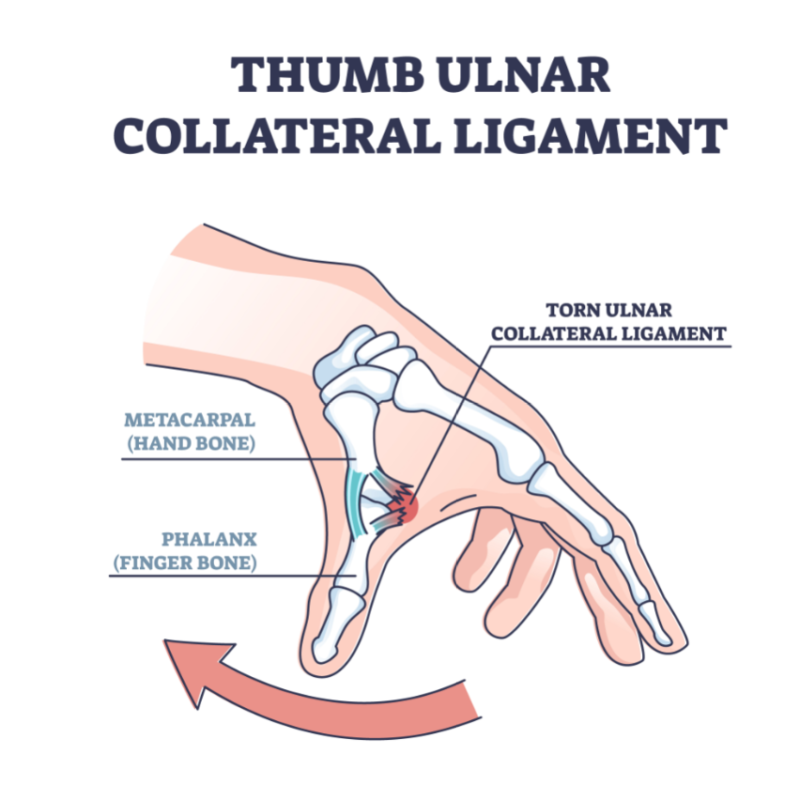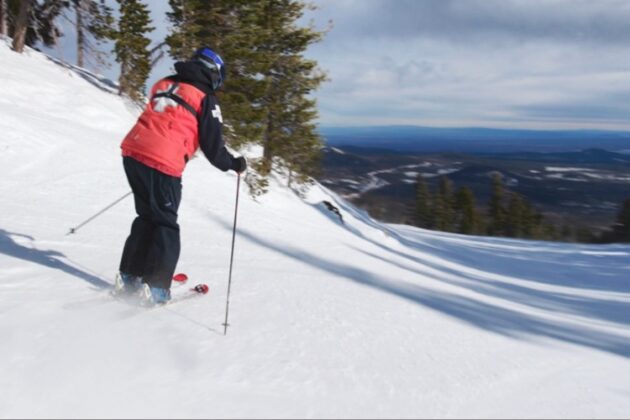
WHAT IS SKIER’S THUMB?
Skier’s Thumb is a common injury, especially in active individuals. Skier’s thumb, also known as “gamekeeper’s thumb”, involves an injury to the ligament on the inside of your thumb – the ulnar collateral ligament (UCL) of the metacarpophalangeal joint. This injury can involve a sprain in which case the ligament stretches, partially tears, or a complete tear leading to significant pain, weakness, and instability of the thumb. The injury occurs most commonly from an acute traumatic event leading to hyperextension of the thumb.
SKIER’S THUMB CAUSES
Skier’s thumb is most common in sports or falls. The thumb can be jammed against another player, ground, ball, or overly bent where one or more ligaments can tear. For example, overly extending your thumb on a ski pole can injure the ulnar collateral ligament.

SKIER’S THUMB SYMPTOMS
Skier’s thumb typically presents with a range of symptoms that can vary in severity depending on the extent of the injury. Common symptoms include:
- Pain: Pain in the thumb, particularly along the inner side or base of the thumb, is a hallmark symptom of skier’s thumb. The pain may be acute and sharp, especially during thumb movement or when pressure is applied to the injured area.
- Swelling: Swelling and inflammation around the thumb joint are common symptoms of skier’s thumb. The swelling may be localized to the thumb or extend to the surrounding tissues, causing discomfort and restricted movement.
- Bruising: Bruising or discoloration of the skin around the thumb joint may occur following an injury to the ulnar collateral ligament (UCL). The bruising is often a result of bleeding beneath the skin and can range from mild discoloration to more pronounced bruising.
- Weakness: Weakness or instability in the thumb joint is another symptom of skier’s thumb. Individuals may experience difficulty gripping objects or performing activities that require thumb strength and coordination.
- Tenderness: Tenderness to the touch is common at the site of the injured ulnar collateral ligament. The thumb joint may feel tender and sensitive, especially when pressure is applied or during thumb movement.
- Instability: In severe cases of skier’s thumb where the UCL is completely torn, individuals may experience thumb joint instability. This can lead to a feeling of looseness or “giving way” in the thumb joint, making it difficult to perform daily activities requiring thumb dexterity.
If you experience this instability with your thumb, contact your hand surgeon for further diagnosis.
SKIER’S THUMB TREATMENT
Treatment depends on the extent of injury to the ligament. In most cases, UCL injuries are treated non-surgically with immobilization, often by casting and then transitioning to a removable brace. In general, it may take up to three months to fully recover and return to normal activity after a sprain/partial tear of the ulnar collateral ligament. Complete tears may be treated surgically or non-surgically depending on the pattern of tear and patient goals. Left untreated, complete tears can lead to chronic pain, weakness, and instability of the thumb.
Conservative Treatment: For mild cases of skier’s thumb where the ligament is sprained but not torn, conservative treatment methods may be sufficient. This typically involves immobilizing the thumb with a splint or brace to allow the ligament to heal properly. Rest, ice, compression, and elevation (RICE) can also help reduce pain and swelling.
Rest: Stop using your hand. Protect the area, and avoid any activity that is painful or may have caused the injury. Continued activity could cause further damage.
Ice: Use ice for the first 48-72 hours after an injury. Apply ice several times a day for 20 minutes at a time, followed by one hour “off.” The cold will contract injured capillaries and blood vessels to help stop internal bleeding. Do not apply ice directly to the skin.
Compression: Wrap your hand firmly with an elasticized bandage, compression sleeve, or cloth – especially when you are more active. This will help speed up healing time by reducing swelling around the injury.
Elevation: Elevate your hand above the level of your heart to decrease swelling and joint pain.
Physical Therapy: Once the initial pain and swelling have subsided, a physical therapy program may be recommended to help restore strength, range of motion, and stability to the thumb. Physical therapy exercises may include gentle stretching, strengthening exercises, and manual therapy techniques to improve thumb function.
Immobilization: In more severe cases where the ulnar collateral ligament (UCL) is completely torn or severely damaged, immobilization with a thumb spica splint or cast may be necessary to allow the ligament to heal. Immobilization typically lasts for several weeks, followed by a period of rehabilitation to regain thumb function.
If your pain persists, x-rays are obtained to ensure there is no fracture to the thumb. Most of the time, the diagnosis can then be made clinically based on your exam and symptoms. Occasionally, advanced imaging such as an MRI will be obtained to evaluate the extent of the tear and help determine treatment options.
Surgery: In cases of severe UCL tears or instability that do not respond to conservative treatment, surgery may be recommended. The surgical procedure typically involves repairing or reconstructing the damaged ligament using sutures or grafts. Surgery may be performed arthroscopically or through an open incision, depending on the extent of the injury.
Rehabilitation: Following surgery or immobilization, rehabilitation is crucial to regain strength, flexibility, and function in the thumb. A structured rehabilitation program supervised by a physical therapist may include progressive exercises, manual therapy, and functional activities tailored to the individual’s specific needs and goals.
PREVENTING SKIER’S THUMB
To safeguard against the risk of skier’s thumb, it’s vital to adopt proactive measures while hitting the slopes. Here are some key strategies to keep in mind:
1. Keep Hands Free of Pole Straps: Ensuring your hands remain outside of pole straps serves as a fundamental precautionary measure. This positioning enables swift and hassle-free pole release in the event of a fall, significantly reducing the risk of thumb injury. Falling onto an outstretched hand without ski poles further diminishes the likelihood of sustaining injury.
2. Choose Poles with Finger-Groove Grips: When selecting ski poles, prioritize those equipped with finger-groove grips. These grips offer enhanced ease of release compared to poles featuring wrist straps or closed grips. Opting for finger-groove grips minimizes the effort required for pole release, contributing to a safer skiing experience.
3. Consider Specialized Ski Gloves: Investing in specially designed ski gloves can provide additional protection against skier’s thumb. Look for gloves engineered to restrict extreme thumb movement and incorporate mechanisms for effortless ski pole release. These gloves not only enhance comfort but also mitigate the risk of thumb injuries during skiing activities.
By incorporating these preventive measures into your skiing routine, you can enjoy the slopes with greater confidence while minimizing the risk of skier’s thumb and other related injuries.
Watch this quick video of orthopedic surgeon and hand specialist, Dr. Soma Lilly, explaining skier’s thumb.





